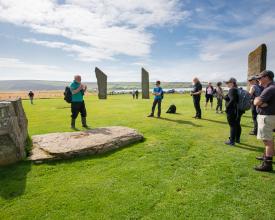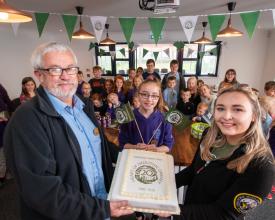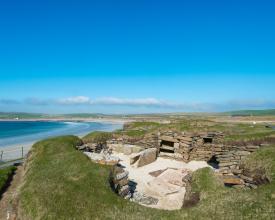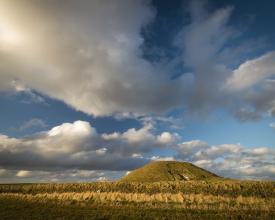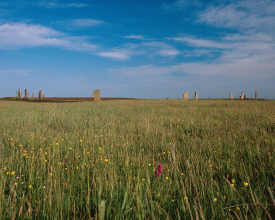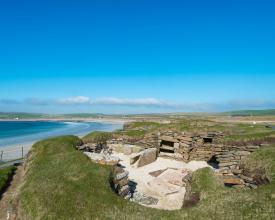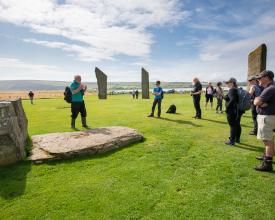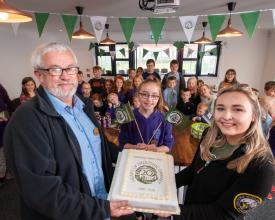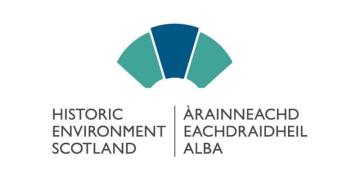
Aumentar la participación de la comunidad y las partes interesadas para la gestión y conservación del Corazón Neolítico de las Orcadas y su paisaje más amplio.
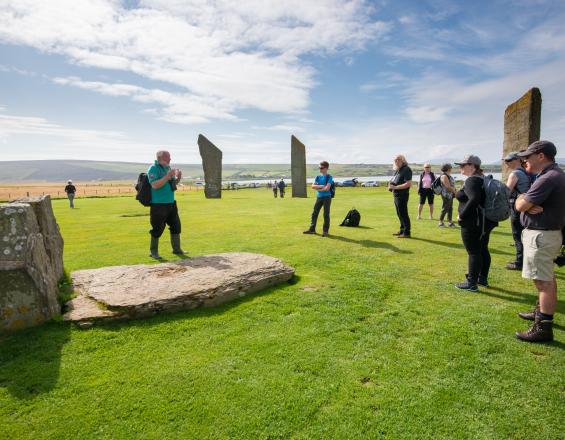
La solución se centra en las disposiciones de gestión del bien Patrimonio Mundial del Corazón de las Orcadas Neolíticas y el reconocimiento de la necesidad de mejorar la participación de la comunidad y las partes interesadas. El lugar desempeña un papel importante en la conformación de la identidad de los orcadianos y, a lo largo de los años, se ha convertido en un elemento fundamental de apoyo a la economía local del archipiélago como motor clave del turismo hacia las Orcadas. La protección de las características naturales y culturales del lugar y su papel en el desarrollo del turismo y las oportunidades de negocio en la isla han exigido la cooperación entre agencias, gobiernos locales y organizaciones benéficas, así como una mayor implicación de las comunidades y empresas locales para el desarrollo de una estrategia de gestión eficaz para la conservación de las Orcadas. Los principales agentes de estas soluciones son Historic Environment Scotland, Orkney Islands Council, NatureScot (antiguo SNH), la Royal Society for the Protection of Birds y Highlands and Islands Enterprise .
Contexto
Défis à relever
- Retos medioambientales: el posible problema de la degradación del sitio debido a los impactos del turismo, especialmente cuando se combina con los impactos del cambio climático, así como la necesidad de garantizar la protección del paisaje circundante que sustenta el Valor Universal Excepcional del Corazón de las Orcadas Neolíticas.
- Retos culturales y sociales: falta de consulta y participación de la comunidad en la toma de decisiones de gestión del Patrimonio Mundial; falta de comprensión / inclusión por parte de los responsables de la toma de decisiones de los valores de la comunidad en relación con el estatus de Patrimonio Mundial y el Valor Universal Excepcional del bien.
- Retos económicos: necesidad de mejorar y potenciar la "distribución de la carga" a través de la conectividad del turismo local con otros sitios culturales y naturales, tanto para reducir la presión máxima sobre los monumentos del Sitio del Patrimonio Mundial como para garantizar y potenciar beneficios comunitarios más amplios para las comunidades, las partes interesadas y las empresas de las Orcadas, incluidas las que no se encuentran en la proximidad inmediata de los componentes del bien del Patrimonio Mundial.
Ubicación
Procesar
Resumen del proceso
La solución pone de relieve la cooperación reforzada y el compromiso comunitario necesarios para garantizar la protección del bien Patrimonio Mundial del Corazón de las Orcadas Neolíticas y el bienestar de sus comunidades y partes interesadas.
La gestión del sitio corre a cargo de un grupo conjunto de dirección del Patrimonio Mundial. Además, se ha creado una asociación estratégica para mejorar la experiencia de los turistas y el beneficio de la población local, que prevé el uso de inversiones para desarrollar una experiencia turística más diversa y completa que llegue a sitios y lugares no relacionados inmediatamente con el sitio. Dado que el turismo en el sitio es a la vez una bendición y una carga, se ha llevado a cabo una campaña de consulta más amplia para comprender mejor las percepciones de la comunidad y las empresas locales en relación tanto con el estatus de Patrimonio Mundial como con los valores turísticos y de otro tipo del sitio. La información recabada pasará a formar parte integrante de los conocimientos e información utilizados para la preparación del nuevo Plan de Gestión del sitio del Patrimonio Mundial y el ulterior desarrollo de la asociación de gestión. Las comunidades desempeñan un papel vital en la conservación del sitio, tanto a través de la buena voluntad y la administración comunitaria, como a través de su participación directa como guardabosques.
Bloques de construcción
Grupo de dirección del sitio del patrimonio mundial Heart of Neolithic Orkney
El Patrimonio Mundial del Corazón Neolítico de las Orcadas se gestiona a través de un Grupo de Dirección integrado y conjunto compuesto por representantes de Historic Environment Scotland (HES), Orkney Islands Council (OIC ), Highlands and Islands Enterprise (HIE), Orkney College University of the Highlands and Islands (UHI) Archaeology Institute, NatureScot (antiguo Scottish Natural Heritage - SNH), y aportaciones de la Royal Society for the Protection of Birds (RSPB). HES gestiona los monumentos individuales que componen la WHS, mientras que los demás socios participan de diversas maneras en la gestión más amplia de la WHS y la zona de amortiguamiento. Un coordinador del SMP garantiza un enlace eficaz entre los socios e impulsa la aplicación, el seguimiento y la revisión del Plan de Gestión y el plan de acción asociado, promueve el VUE y el beneficio público del SMP, aumenta la concienciación y la comprensión entre los socios, las partes interesadas y el público, y sirve de punto central de asesoramiento.
Además, el Grupo de Dirección también es responsable de garantizar la protección de las relaciones y vínculos entre los monumentos y el paisaje en general. Las zonas situadas entre los monumentos que componen el bien del Patrimonio Mundial y las que se encuentran fuera de él y que sustentan el VUE están potencialmente en peligro debido a los cambios y al desarrollo del paisaje.
Factores facilitadores
Las competencias integradas naturaleza-cultura del Grupo Director, a través de su cooperación multidisciplinar entre los socios gestores, son necesarias para la protección de los valores culturales y naturales del Corazón de las Orcadas Neolíticas.
Lección aprendida
- La experiencia del anterior ciclo del plan de gestión y la cooperación entre las partes interesadas institucionales multidisciplinares ha puesto de relieve la necesidad de un cambio de enfoque en el Plan de Gestión revisado, que se basa firmemente en las relaciones entre el bien del Patrimonio Mundial del Corazón Neolítico de las Orcadas y el paisaje terrestre y marino más amplio del archipiélago.
- El enfoque de gestión integrada es clave para la protección del bien del Patrimonio Mundial del Corazón Neolítico de las Orcadas y su Valor Universal Excepcional, en particular cuando se trata de propuestas de infraestructura y otras propuestas de desarrollo (un ejemplo son las propuestas anteriores para la construcción de turbinas eólicas e instalaciones relacionadas).
- La gestión del bien del Patrimonio Mundial del Corazón Neolítico de las Orcadas debe integrarse en una planificación local y nacional más amplia, que tenga en cuenta no sólo el sitio en sí, sino también el entorno más amplio del bien y su paisaje circundante.
Asociación para mejorar la experiencia de los turistas y beneficiar a la población local
El turismo es una industria clave para la economía y fuente de empleo para las comunidades y empresas locales de las Orcadas y, por tanto, contribuye a la sostenibilidad a largo plazo de sus comunidades y empresas. Dado que el Sitio del Patrimonio Mundial y las Orcadas en general se enfrentan a retos clave, como el cambio climático y los impactos del turismo de volumen durante las horas punta, se ha creado una asociación formal entre los principales organismos nacionales y locales para abordar estos retos y oportunidades que plantea el turismo. Esta asociación reúne a HES, OIC y HIE, centrándose en el yacimiento del Corazón Neolítico de las Orcadas, aunque sin limitarse a él, con el fin de garantizar una experiencia sostenible y mejorada para los turistas y optimizar los beneficios para la población local.
La asociación prevé un desarrollo de oportunidades turísticas diferentes y más inclusivas y sostenibles para las Orcadas de la mano del plan de gestión del yacimiento. Una inversión inicial de más de 300.000 libras en los Stones of Stenness modernizará los aparcamientos y mejorará la red de senderos para fomentar una mayor conexión entre los monumentos y las zonas naturales y culturales circundantes.
Factores facilitadores
La asociación estratégica Gateway se establece sobre la base de un Memorando de Entendimiento (MOU) compartido firmado el 11 de junio de 2019 por Historic Environment Scotland (HES), Orkney Islands Council (OIC) y Highlands and Islands Enterprise (HIE).
Lección aprendida
- Se asignarán fondos adicionales para el desarrollo del viaje de los visitantes y la exploración de oportunidades para una mayor conectividad y mejora de la forma en que los visitantes experimentan más de 5.000 años de historia.
- La industria turística es vital para la sostenibilidad de los medios de vida en las Orcadas. Los visitantes no sólo vienen a las Orcadas para visitar la propiedad Patrimonio de la Humanidad del Corazón de las Orcadas Neolíticas y existe el potencial para fortalecer la red de lugares naturales y culturales y las oportunidades de los visitantes para compartir los beneficios relacionados con el turismo y los ingresos entre las múltiples empresas y comunidades.
- En la actualidad, con la limitación de la pandemia de Covid-19, es difícil cuantificar mejor el impacto de estos esfuerzos, ya que el yacimiento de las Orcadas ha permanecido cerrado durante gran parte de la temporada de verano de 2020 y la entrada en Escocia sigue estando limitada a una serie de nacionalidades. Sin embargo, esta "pausa" no planificada ha permitido a los socios seguir reflexionando sobre cómo abordar estos retos.
Servicio de Guardaparques
El corazón de las Orcadas Neolíticas es de gran importancia para la identidad local de los orcadianos y la administración y el compromiso locales son vitales para garantizar una gestión adecuada y eficaz del yacimiento y de su entorno paisajístico más amplio. Desde 2005 existe un servicio de guardas para atender tanto a los visitantes de los yacimientos como a los miembros de la comunidad local y a los residentes. Se han añadido puestos de guardabosques estacionales con guardabosques voluntarios ocupados por residentes locales que trabajan junto a los guardabosques del Sitio del Patrimonio Mundial empleados por Historic Environment Scotland.
Los guardas voluntarios desempeñan un papel importante en la protección del patrimonio natural y cultural de las Orcadas, ya que ayudan con patrullas a pie, supervisión de eventos de terceros, paseos guiados y apoyo a grupos escolares y comunitarios. Están en primera línea en el compromiso con el público y participan activamente para garantizar un acceso seguro y responsable al sitio y su disfrute.
Se han creado servicios de guardas en una serie de propiedades gestionadas por Historic Environment Scotland como medida para fomentar la buena voluntad, el sentimiento de responsabilidad y la administración de las comunidades locales y las partes interesadas.
Factores facilitadores
El programa de voluntariado está organizado por Historic Environment Scotland y cuenta con el apoyo de los guardabosques que trabajan en el yacimiento. A los guardabosques voluntarios se les proporciona un uniforme de guardabosques y toda la información necesaria para acoger y guiar las visitas al yacimiento. Con el tiempo, los voluntarios han pasado a ser guardas estacionales contratados.
Lección aprendida
- Los guardas desempeñan un papel fundamental a la hora de garantizar una experiencia de alta calidad a los visitantes. Hacen que la historia y los lugares cobren vida para los miles de visitantes que acuden a las Orcadas cada año. Realizan paseos diurnos y nocturnos, además de organizar y llevar a cabo visitas especiales para grupos escolares y comunitarios. Además, los guardas participan en la creación de nuevas oportunidades y actividades para las personas que visitan el yacimiento durante todo el año y en múltiples condiciones meteorológicas.
- La función de los guardabosques es garantizar el equilibrio entre la conservación del yacimiento y la experiencia de los visitantes, sobre todo en los yacimientos más frágiles, como el Anillo de Brodgar y las Piedras de Stenness.
- El programa de guardaparques es una oportunidad para el desarrollo de capacidades, ya que permite mejorar y reforzar las aptitudes profesionales y personales.
Consulta a la comunidad y a las partes interesadas locales para el Plan de Gestión del Corazón Neolítico de las Orcadas
El Corazón de las Orcadas Neolíticas desempeña un papel importante en la identidad local y es clave para la sostenibilidad de la economía y las empresas turísticas locales.
Como parte del proceso de elaboración de un nuevo plan de gestión, se pidió a las comunidades locales, los residentes y las empresas que expresaran sus opiniones sobre la futura gestión del Corazón de las Orcadas Neolíticas. A principios de 2020, se llevó a cabo una campaña de consulta a través de métodos cuantitativos y cualitativos que incluían una encuesta (tanto en línea como en papel) y una serie de tres sesiones de consulta que tuvieron lugar en el St Magnus Centre, Kirkwall; el Maeshowe Visitor Centre, Stenness y el Milestone Community Centre, Dounby. También se celebraron consultas y reuniones con organizaciones comunitarias locales.
La consulta se centró en comprender el valor del Corazón de las Orcadas Neolíticas, así como el papel que la designación como Patrimonio Mundial tiene para las comunidades y empresas locales. La consulta también exploró cómo mejorar la comunicación con las partes interesadas locales y abordó la cuestión de sus prioridades clave para el futuro del sitio.
Factores facilitadores
El ejercicio de participación de la comunidad fue llevado a cabo por un consultor independiente encargado por el Grupo Director. En la consulta participaron 95 personas y organizaciones, incluidos alumnos de primaria y secundaria, empresas, residentes y representantes de diversos grupos y organizaciones de la comunidad (por ejemplo, agricultores y terratenientes, apasionados de la historia y el patrimonio).
Lección aprendida
El compromiso de la comunidad reveló información importante y percepciones de la comunidad que son clave para la preparación del nuevo plan de gestión del Corazón de las Orcadas Neolíticas:
- El estatus de Patrimonio de la Humanidad es importante para atraer el turismo a las Orcadas, pero también puede ser una limitación, ya que su interpretación centrada no aborda la historia más amplia de las Orcadas.
- Un enfoque más amplio y conjunto del turismo, que incluya también los lugares que no son Patrimonio de la Humanidad, ayudaría a evitar la situación de cuello de botella durante los meses punta.
- El atractivo turístico de las Islas Orcadas no se debe únicamente al estatus de Patrimonio de la Humanidad de parte de su patrimonio, sino a la amplia gama de sitios culturales y naturales y también a sus productos locales (carne de vacuno, industria ovina, whisky, productos locales de marca), que es un aspecto clave para las empresas locales y su sostenibilidad.
- Los residentes expresaron una fuerte conexión con la historia de las Islas Orcadas y su gente y el deseo de ver esto plenamente representado y conectado con el fin de compartir con el mundo.
- Existe la necesidad de mejorar las instalaciones comunitarias que se han deteriorado con el paso del tiempo, y el turismo podría utilizarse como catalizador para financiar la renovación y mejora de dichas instalaciones
Impactos
- Cultural y social: el enfoque establecido para la gestión del sitio y el futuro desarrollo de oportunidades turísticas ha identificado el paisaje más amplio como de gran importancia para la protección del Valor Universal Excepcional del Corazón de las Orcadas Neolíticas.Las disposiciones para la protección del paisaje están presentes dentro de la legislación y las políticas de planificación nacional y local.
- Cultural y social: la solución identificó la importancia de las comunidades locales, las partes interesadas y las empresas en la gestión y conservación del sitio. El Corazón de las Orcadas Neolíticas es importante para la comunidad local no sólo por su condición de Patrimonio de la Humanidad, sino también por su papel como elemento clave de la identidad cultural orcadiana; las comunidades están dispuestas a comprometerse con el yacimiento y su gestión y están interesadas en participar en un diálogo, no sólo en recibir información. Reforzar los canales de comunicación entre la gestión del sitio y las partes interesadas y comunidades locales tiene beneficios para la gestión del sitio y la comprensión de su(s) valor(es) por ambas partes;
- El turismo es una industria clave para la población de las Orcadas. Para gestionar el turismo de forma sostenible se requiere un enfoque paisajístico más amplio que incluya sitios no incluidos en el Patrimonio Mundial, así como áreas de interés natural y cultural más amplias.
Beneficiarios
Los beneficiarios de esta solución son las comunidades y empresas locales de las Islas Orcadas. La solución se centra en mejorar la participación y trabajar para conseguir oportunidades turísticas más integradas y sostenibles para las Orcadas.
Historia
La guardabosques Sandra Miller pasa más tiempo que la mayoría disfrutando del paisaje del Corazón Neolítico de las Orcadas. Centrándose especialmente en el Anillo de Brodgar y las Piedras de Stenness, ella y el equipo de guardabosques pasan mucho tiempo conociendo a personas de todo el mundo que han venido a ver los increíbles lugares que ofrecen las Orcadas. En el día a día, interpretan cara a cara el paisaje natural e histórico de esta zona emblemática.
Para Sandra, pasar tiempo con visitantes y lugareños por igual es una de las mejores partes de su trabajo, ya que le sirve para recordar cada día lo especiales que son los monumentos. El gran número de visitantes y la facilidad de acceso plantean siempre el reto de la protección de los sitios. Entendiendo que la gente quiere vivir la mejor experiencia posible y ver todo lo que pueda, se trata de encontrar el equilibrio adecuado. Sandra y su equipo evolucionan constantemente sus ideas y planteamientos para garantizar una experiencia excelente a los visitantes, pero también para proteger la arqueología y el paisaje natural. Para Sandra es fundamental que los jóvenes de las Orcadas comprendan la singularidad de los yacimientos y del paisaje que los rodea. Por ello, las visitas a los colegios son una parte importante de su trabajo, que todos los guardas disfrutan, pues sienten que no sólo protegen el yacimiento para hoy, sino también para las generaciones futuras.
